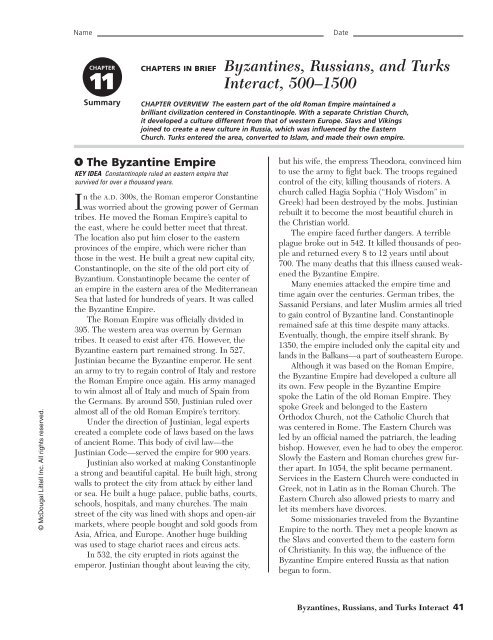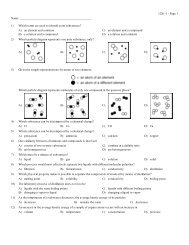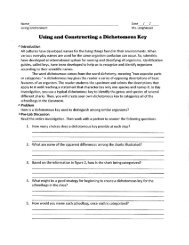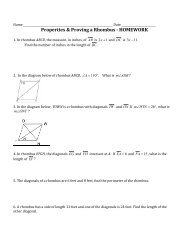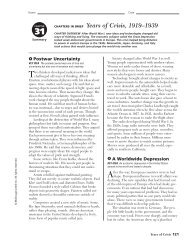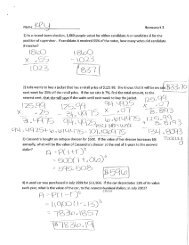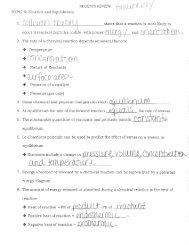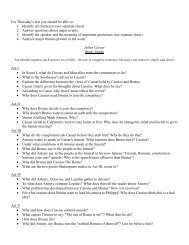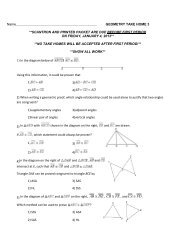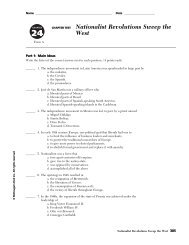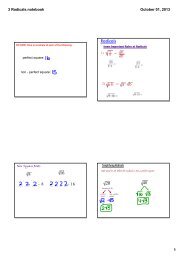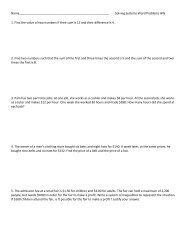Chapter 11 Summary.pdf - stephenkocis
Chapter 11 Summary.pdf - stephenkocis
Chapter 11 Summary.pdf - stephenkocis
- No tags were found...
Create successful ePaper yourself
Turn your PDF publications into a flip-book with our unique Google optimized e-Paper software.
NameDateCHAPTER<strong>11</strong><strong>Summary</strong>CHAPTERS IN BRIEFByzantines, Russians, and TurksInteract, 500–1500CHAPTER OVERVIEW The eastern part of the old Roman Empire maintained abrilliant civilization centered in Constantinople. With a separate Christian Church,it developed a culture different from that of western Europe. Slavs and Vikingsjoined to create a new culture in Russia, which was influenced by the EasternChurch. Turks entered the area, converted to Islam, and made their own empire.© McDougal Littell Inc. All rights reserved.1The Byzantine EmpireKEY IDEA Constantinople ruled an eastern empire thatsurvived for over a thousand years.In the A.D. 300s, the Roman emperor Constantinewas worried about the growing power of Germantribes. He moved the Roman Empire’s capital tothe east, where he could better meet that threat.The location also put him closer to the easternprovinces of the empire, which were richer thanthose in the west. He built a great new capital city,Constantinople, on the site of the old port city ofByzantium. Constantinople became the center ofan empire in the eastern area of the MediterraneanSea that lasted for hundreds of years. It was calledthe Byzantine Empire.The Roman Empire was officially divided in395. The western area was overrun by Germantribes. It ceased to exist after 476. However, theByzantine eastern part remained strong. In 527,Justinian became the Byzantine emperor. He sentan army to try to regain control of Italy and restorethe Roman Empire once again. His army managedto win almost all of Italy and much of Spain fromthe Germans. By around 550, Justinian ruled overalmost all of the old Roman Empire’s territory.Under the direction of Justinian, legal expertscreated a complete code of laws based on the lawsof ancient Rome. This body of civil law—theJustinian Code—served the empire for 900 years.Justinian also worked at making Constantinoplea strong and beautiful capital. He built high, strongwalls to protect the city from attack by either landor sea. He built a huge palace, public baths, courts,schools, hospitals, and many churches. The mainstreet of the city was lined with shops and open-airmarkets, where people bought and sold goods fromAsia, Africa, and Europe. Another huge buildingwas used to stage chariot races and circus acts.In 532, the city erupted in riots against theemperor. Justinian thought about leaving the city,but his wife, the empress Theodora, convinced himto use the army to fight back. The troops regainedcontrol of the city, killing thousands of rioters. Achurch called Hagia Sophia (“Holy Wisdom” inGreek) had been destroyed by the mobs. Justinianrebuilt it to become the most beautiful church inthe Christian world.The empire faced further dangers. A terribleplague broke out in 542. It killed thousands of peopleand returned every 8 to 12 years until about700. The many deaths that this illness caused weakenedthe Byzantine Empire.Many enemies attacked the empire time andtime again over the centuries. German tribes, theSassanid Persians, and later Muslim armies all triedto gain control of Byzantine land. Constantinopleremained safe at this time despite many attacks.Eventually, though, the empire itself shrank. By1350, the empire included only the capital city andlands in the Balkans—a part of southeastern Europe.Although it was based on the Roman Empire,the Byzantine Empire had developed a culture allits own. Few people in the Byzantine Empirespoke the Latin of the old Roman Empire. Theyspoke Greek and belonged to the EasternOrthodox Church, not the Catholic Church thatwas centered in Rome. The Eastern Church wasled by an official named the patriarch, the leadingbishop. However, even he had to obey the emperor.Slowly the Eastern and Roman churches grew furtherapart. In 1054, the split became permanent.Services in the Eastern Church were conducted inGreek, not in Latin as in the Roman Church. TheEastern Church also allowed priests to marry andlet its members have divorces.Some missionaries traveled from the ByzantineEmpire to the north. They met a people known asthe Slavs and converted them to the eastern formof Christianity. In this way, the influence of theByzantine Empire entered Russia as that nationbegan to form.Byzantines, Russians, and Turks Interact 41
NameByzantines, Russians, and Turks Interact continued© McDougal Littell Inc. All rights reserved.Beginning in the 900s, they moved into the lands ofthat empire and began converting to Islam.These fierce nomads were highly skilled fighters.The rulers of the empire began to buy them as childrento train them for their armies. Turks becamean important political factor in the empire. Turkishsoldiers many times removed caliphs from thethrone in Baghdad and put new rulers in place.While this Turkish influence was growing, theempire itself was shrinking. Local leaders in severalareas split off to establish their own states. In 945, aPersian army seized control of the empire. Membersof the Abbasid family continued to hold the positionof caliph and act as religious leaders. The new rulersof the government were from outside the dynasty.They were called sultans.As these changes took place, larger and largernumbers of Turks settled in the empire. They werecalled Seljuk Turks after the name of the family thatled them. In 1055, the Seljuks captured Baghdadand took control of the government. In the next fewdecades, the Seljuks used their force to take landaway from another empire—the Byzantine Empire.They won almost all of Anatolia, the peninsulawhere modern Turkey now sits. In this position,they stood almost at the gates of Constantinople.In ruling their empire, the Seljuks relied on thegovernment experience of Persians. They placedtheir capital in Persian lands and gave Persiansimportant positions in the government. In return,Persians became loyal supporters of Turkish rule.The Turks also adopted Persian culture. Theylooked to Persian scholars to teach them the properway to follow Islam. They began to use the Persianlanguage for art and education. The Turkish rulerseven took the Persian word for “king”—shah—astheir title. One of the greatest Seljuk rulers, MalikShah, became a patron of the arts. He made thecapital city more beautiful by building manymosques, or Muslim houses of worship. Persianbecame so important that Arabic—the language ofthe Qur’an—almost died out in Seljuk lands.The Seljuk Empire collapsed quickly, as a seriesof weak rulers were unable to maintain it. Onereason was the growing pressure from westernEurope, whose rulers sent armies on the Crusadesin the effort to capture the lands of ancientPalestine, which were sacred to Christians. The FirstCrusade began in 1095, and the Christian armiescaptured Jerusalem. Not quite 100 years later, theTurks retook the city.Just when the Crusades became less of a threatto the Muslim world, the Mongols moved in fromthe east. They overran vast stretches of territoryand captured Baghdad in 1258. They killed the lastcaliph and took control of the government from theSeljuk Turks.Review1. Determining Main Ideas Describe two accomplishmentsof the emperor Justinian.2. Contrasting What cultural factors separated theByzantine Empire from western Europe?Analyzing Causes and Recognizing Effects3. What cultural influences combined to produceRussian culture?4. What effects did Mongol rule have on Russianhistory?5. Comparing How was the Turkish adoption ofculture similar to the adoption of culture by theRussians?Byzantines, Russians, and Turks Interact 43


